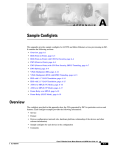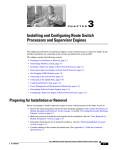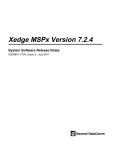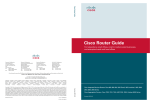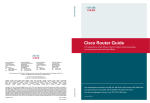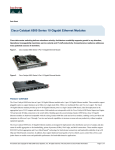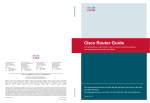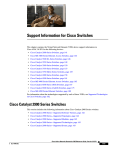Download Cisco 7600 Series SPA Interface Processor-200, spare
Transcript
Data Sheet Cisco 7600 Series SPA Interface Processor-200 ® The Cisco I-Flex design combines shared port adapters (SPAs) and SPA interface processors (SIPs), leveraging an extensible design that enables service prioritization for voice, video and data services. Enterprise and service provider customers can take advantage of improved slot economics resulting from modular port adapters that are interchangeable across Cisco routing platforms. The I-Flex design maximizes connectivity options and offers superior service intelligence through programmable interface processors that deliver line-rate performance. I-Flex enhances speed-to-service revenue and provides a rich set of QoS features for premium service delivery while effectively reducing the overall cost of ownership. Product Overview The Cisco 7600 SIP-200 helps enable high-performance, intelligent WAN services. Enterprises and service providers can take full advantage of the increased scalability, performance, and rich features offered by the Cisco 7600 SIP-200, along with the many options for WAN aggregation and connectivity offered in the Cisco SPA/SIP portfolio. The Cisco 7600 SIP-200 provides feature parity with the Enhanced FlexWAN while offering twice the performance and increased scalability. Figure 1. Cisco 7600 SIP-200 Cisco 7600 Series Routers offer innovative, next-generation converged services for enterprises and service providers. Built on foundation technologies such as security, QoS, and high availability, the Cisco SPA/SIP portfolio helps enable the delivery of these value-added services for new revenue streams. The Cisco 7600 SIP-200 is supported both on Cisco 7600 platform and Catalyst 6500 platform. Applications Ideal for enterprise headend and service provider edge aggregation, the Cisco 7600 SIP-200 supports up to 622Mbps of bandwidth, and numerous interfaces. The innovative architecture of this industry-leading WAN services module delivers Cisco 7500 Series feature parity and feature velocity for time-to-market solutions. All contents are Copyright © 1992–2007 Cisco Systems, Inc. All rights reserved. This document is Cisco Public Information. Page 1 of 7 Data Sheet Enterprise and Service Provider WAN Aggregation The Cisco 7600 SIP-200 helps enterprises and service providers deploy high-density WAN aggregation, based on Frame Relay, Point-to-Point Protocol (PPP), High-Level Data Link Control (HDLC), ATM, or Packet over SONET/SDH (POS). Additionally, service providers can take advantage of the Multiprotocol Label Switching (MPLS) and Any Transport over MPLS (AtoM) options supported on the Cisco 7600 SIP-200 to offer Layer 2 and Layer 3 VPNs. Rich QoS features and distributed processing attributes of the Cisco 7600 SIP-200 make it a cornerstone of a highly scalable WAN aggregation solution. Higher-layer applications can easily be supported on this end-to-end network to allow intelligent data, voice, video, and security services – all on the same platform – to provide integrated, easy-to-use application delivery and control. Service Convergence and Intelligent Network Services for Next-Generation Applications The unique value the Cisco 7600 Series provides is the convergence supported from the physical layer to a highly scalable application layer. The Cisco 7600 SIP-200 simplifies network design and deployment by allowing consolidation of LAN, WAN, and metropolitan-area network (MAN) interfaces into a single, highly scalable platform. The Cisco 7600 SIP-200, by integrating WAN termination, rich QoS features, bandwidth optimization, and security on the same module, obviates the need for multiple service modules, offering tremendous cost savings. The rich classification features supported on the Cisco 7600 SIP-200 enable identification of packets from Layer 2 to Layer 7 of the OSI model, enabling application-level intelligence and security in the network. Features and Benefits The rich QoS features of the Cisco 7600 SIP-200 enable users to: ● Classify and mark packets for QoS treatment within the network ● Deliver bandwidth to business-critical applications ● Limit bandwidth to non-critical applications ● Avoid network congestion by dropping select low-priority packets ● Smooth out bursts and avoid packet discard in the network In addition, low-speed WAN aggregation features supported include: ● Compressed Real-Time Protocol (cRTP) to maximize bandwidth utilization ● Distributed link fragmentation and interleaving (dLFI) to minimize jitter ● Multilink PPP (MLPPP), Multilink Frame Relay Protocol (MLFR), ATM VC Bundle, and Frame Relay VC Bundle to bundle multiple low-speed links Table 1 summarizes the features and benefits of the Cisco 7600 SIP-200. Table 1. Features and Benefits of Cisco 7600 SIP-200 Features and SPAs support varies depending on software release. Please consult the Cisco 7600 and Catalyst 6500 release notes to determine support. Feature Benefit Services A feature-rich WAN services card for QoS, bandwidth optimization, and security Eliminates the need for multiple service modules; reduces costs Modularity Supports up to 4 SPAs per module Provides high-density aggregation, with a combination of interface types and the capability to invest as you grow Investment Protection SPA support across midrange and high-end routers Allows SPAs to be reused across Cisco product portfolio CPU 1.1-Mpps bidirectional packet-forwarding performance with 46-byte packets Provides high-density aggregation All contents are Copyright © 1992–2007 Cisco Systems, Inc. All rights reserved. This document is Cisco Public Information. Page 2 of 7 Data Sheet Feature Benefit Memory (Default) 512 MB Memory Upgrade Option 1 GB Maximum Enables support of large routing tables, rich QoS features, and increased scalability Switch Fabric Connectivity Supported Uses 720-Gbps switch fabric module Online Insertion and Removal SIP and SPA OIR are supported Increases availability and provides operational ease of use The Cisco SPA/SIP portfolio offers the following additional advantages: ● Industry’s most modular, flexible, intelligent interface processors ◦ Unmatched flexibility, providing mix-and-match of interface types on the same interface processor for consistent services, independent of access technology. ◦ Pioneering programmable interface processors that provide flexibility for the service diversity required in next-generation networks. ◦ Innovative design that provides intelligent delivery of services without compromising on performance. ● Increase speed to service revenue ◦ The future-proof programmable Cisco architecture extended to 10 Gigabits per second dramatically improves customer density, increasing potential revenue per platform. ◦ Interface breadth (copper, channelized, POS, ATM, and Ethernet) on a modular interface processor allows service providers to more quickly roll out new services, ensuring all customers large and small receive conistent, secure, and guaranteed services. ◦ High-density SFP interfaces are featured for high-port-count applications with reach flexibility. Future optical technology improvements can be adopted using existing SPAs. ● Dramatically improve the financials of your routing purchase ◦ Improved slot economics and increased density reduce capital expenditures (CapEx). ◦ The ability to easily add new interfaces as they are needed enables a "pay-as-you-grow" business model while still offering a high-density solution. ◦ SPAs are shared across multiple platforms, and can be easily moved from one to another, providing consistent feature support, accelerated product delivery, and a significant reduction in operating expenses (OpEx) through common sparing as service needs change. Product Specifications Table 2 provides the product specifications of the Cisco 7600 SIP-200. Table 2. Product specifications of Cisco 7600 SIP-200 Feature Specification Compatibility Cisco 7600 Series SUP32-3B, SUP720-3B, SUP720-3BXL, RSP720-3C, RSP7203CXL, RSP720-3C-10G, and RSP720-3CXL-10G systems Minimum Software Compatibility Cisco IOS® Software Release 12.2(18)SXE, or later Protocols ● TCP ● User Datagram Protocol (UDP) ● IPv4 Unicast and Multicast ● IPv6 Unicast and Multicast ● MPLS All contents are Copyright © 1992–2007 Cisco Systems, Inc. All rights reserved. This document is Cisco Public Information. Page 3 of 7 Data Sheet Feature Encapsulation Specification ● Frame Relay ● Multilink Frame Relay – FRF.16 ● PPP ● MLPPP ● Bridge Control Protocol (BCP) ● High-Level Data Link Control (HDLC) ● ATM permanent virtual circuit (PVC)-constant bit rate (CBR), variable bit rate realtime (VBR-rt), VBR non-real-time (VBR-nrt), and unspecified bit rate (UBR) ● ATM switched virtual circuit (SVC)-CBR, VBR-rt, VBR-nrt, UBR, and UBR+ ● POS Cards, Ports, and Slots Four SPA bays per Cisco 7600 SIP-200. The SIP-200 supports oversubscription. QoS, Access Control Lists (ACLs), and Low-Speed Aggregation Features QoS ● Modular QoS CLI (MQC) ● Classification ◦ ACLs ◦ IP Precedence ◦ IPv4 and IPv6 ◦ Differentiated services code point (DSCP) ◦ MPLS experimental values (MPLS EXP) ◦ Frame Relay Discard Eligibility ◦ ATM cell loss priority (CLP) ● QoS mappings – CLP, DE to IP type of service (ToS), MPLS EXP; and conversely ● Hierarchical QoS Queuing ● Per-virtual circuit queuing ● Low-latency queuing (LLQ) ● Weighted Fair Queuing (WFQ) ● Class-Based Weighted Fair Queuing (CBWFQ) Congestion Avoidance Traffic Marking, Shaping, and Bandwidth Policing Weighted Random Early Detection (WRED) ● Marking – IP Precedence, DSCP, MPLS EXP, ATM CLP, and FR DE ● Policing ● Distributed traffic shaping (DTS) ● Hierarchical traffic shaping ● Distributed network-based application recognition (NBAR) Fragmentation ● Distributed link fragmentation and interleaving (dLFI) ● Frame Relay Forum FRF.12 ACLs and Security ● Standard, extended, dynamic, reflexive, and time-based ACLs ● Classification based on packet length Bandwidth Efficiency ● cRTP ● ATM permanent-virtual-circuit (PVC) bundles ● Frame Relay virtual circuit bundles Layer 2 Bridging and Interworking ● RFCs 1483 and RFC 2684 ATM Virtual Circuits – Routed and Bridged ● RFC 1490 Frame Relay Virtual Circiuts – Routed and Bridged ● Multipoint Bridging for RFC 1483 virtual circuits ● Multipoint Bridging for RFC 1490 virtual circuits ● Bridge Control Protocol ● Bridging of routed encapsulation ● Routed bridged encapsulation Layer 2 and Layer 3 VPNs ● RFC 2547 MPLS VPNs ● Ethernet over MPLS (EoMPLS) ● ATM over MPLS (ATMoMPLS) ● ATM Adaptation Layer 5 (AAL5) virtual circuit mode, single-cell relay virtual circuit mode ● Frame Relay over MPLS (FRoMPLS) ● PPP over MPLS (PPPoMPLS) ● HDLC over MPLS (HDLCoMPLS) ● Virtual circuit-to-virtual circuit local switching – Frame Relay, ATM – AAL0, AAL5 All contents are Copyright © 1992–2007 Cisco Systems, Inc. All rights reserved. This document is Cisco Public Information. Page 4 of 7 Data Sheet Feature High Availability Specification ● Nonstop forwarding (NSF) ● Stateful switchover (SSO) ● Automatic Protection Switching (APS) with ATM, POS SPAs ● OIR Memory Supported SPAs ● 512-MB default Double Data Rate (DDR) synchronous dynamic RAM (SDRAM) ● Optionally upgradable to 1-GB DDR SDRAM memory ATM ● Cisco 2-Port OC-3c/STM-1c ATM Shared Port Adapter ● Cisco 4-Port OC-3c/STM-1c ATM Shared Port Adapter POS/Channelized ● Cisco 2-Port OC-3c/STM-1c POS Shared Port Adapter ● Cisco 4-Port OC-3c/STM-1c POS Shared Port Adapter ● Cisco 1-Port Channelized OC-3c/STM-1c POS Shared Port Adapter Copper/Channelized ● Cisco 8-Port Channelized T1/E1 Shared Port Adapter ● Cisco 2-Port Clear Channel T3/E3 Shared Port Adapter ● Cisco 4-Port Clear Channel T3/E3 Shared Port Adapter ● Cisco 2-Port Channelized T3 (DS0) Shared Port Adapter ● Cisco 4-Port Channelized T3 (DS0) Shared Port Adapter Fast Ethernet ● Cisco 4-Port Fast Ethernet Shared Port Adapter ● Cisco 8-Port Fast Ethernet Shared Port Adapter Environmental Conditions ● Operating temperature: 32 to 104°F (0 to 40°C) ● Storage temperature: –40 to 167°F (–20 to 70°C) ● Relative humidity: 10 to 90%, noncondensing ● Operating altitude: –60 to 2000m MIBs ● Cisco Entity MIB (CISCO-ENTITY-MIB) ● Cisco Entity Asset MIB ● CISCO-ENTITY-VENDOR-OIDTYPE-MIB OID ● Cisco Entity Field-Replaceable Unit (FRU) Control MIB ● CISCO-ENHANCED-MEMPOOL-MIB ● CISCO-PROCESS-MIB ● CISCO-ENVMON-MIB ● Cisco Entity Alarm MIB ● Simple Network Management Protocol (SNMP) MIB II (RFC 1213) ● Remote Monitoring (RMON) MIB (RFC 1757) Network Management ● Supported with CiscoWorks CiscoView ● CiscoWorks Resource Manager Essentials (RME) ● Cisco IP Solution Center (ISC) Physical Specifications ● Occupies one slot in a Cisco 7600 Series Router ● Supports up to 12 Cisco 7600 SIP-200s in a 13-slot chassis ● Requires Supervisor Engine SUP32-3B, SUP720-3B, SUP720-3BXL, RSP720-3C, RSP720-3CXL, RSP720-3C-10G, or RSP720-3CXL-10G ● Dimensions (H x W x D): 1.74 x 15.3 x 17 in. ● Weight: 8.5 lb Power Indicators ● 160W power consumption per Cisco 7600 SIP-200 ● 240W maximum power consumption with Cisco 7600 SIP-200 and 4 SPAs Cisco 7600 SIP-200 status: ● green (operational) ● orange (faulty) Regulatory Compliance CE marking All contents are Copyright © 1992–2007 Cisco Systems, Inc. All rights reserved. This document is Cisco Public Information. Page 5 of 7 Data Sheet Feature Specification ● UL 60950 ● CSA C22.2 No. 60950 Safety ● EN60950 ● TS001 ● IEC 60950 ● AS/NZS3260 ● FCC Part 15 Class A ● ICES-003 Class A EMC ● VCCI Class A ● EN55022 Class A ● EN55024 ● EN50082-1 ● CISPR22 Class A ● ETS-300 386 ● ITU-T G.610 ● ITU-T G.703 Telecommunications Standards ● ITU-T G.707 ● ITU-T G.783 Sections 9-10 ● ITU-T G.784 ● ITU-T G.803 ● ITU-T G.813 ● ITU-T G.825 ● ITU-T G.826 ● ITU-T G.841 ● ITU-T G.957 Table 3 ● ITU-T G.958 ● ITU-T I.361 ● ITU-T I.363 ● ITU I.432 ● ITU-T Q.2110 ● ITU-T Q.2130 ● ITU-T Q.2140 ● ITU-T O.151 ● ITU-T O.171 ● ETSI ETS 300 417-1-1 ● ACA TS 026 (1997) ● BABT/TC/139 (Draft 1e) Ordering Information To place an order, visit the Cisco Ordering Home Page, or refer to Table 3. Table 3. Ordering Information Part Number Product Name 7600-SIP-200 Cisco 7600 Series SPA Interface Processor-200 7600-SIP-200= Cisco 7600 Series SPA Interface Processor-200, spare MEM-SIP-200-512M 512 MB memory for Cisco 7600 SIP-200 MEM-SIP-200-512M= 512 MB memory for Cisco 7600 SIP-200, spare MEM-SIP-200-1G 1 GB memory for Cisco 7600 SIP-200 MEM-SIP-200-1G= 1 GB memory for Cisco 7600 SIP-200, spare All contents are Copyright © 1992–2007 Cisco Systems, Inc. All rights reserved. This document is Cisco Public Information. Page 6 of 7 Data Sheet Service and Support Cisco offers a wide range of services programs to accelerate customer success. These innovative services programs are delivered through a unique combination of people, processes, tools, and partners, resulting in high levels of customer satisfaction. Cisco services help you protect your network investment, optimize network operations, and prepare your network for new applications to extend network intelligence and the power of your business. For more information about Cisco services, refer to Cisco Technical Support Services or Cisco Advanced Services. For More Information For more information about Cisco 7600 Series Routers, visit http://www.cisco.com/go/7600. For more information about the Cisco SPA/SIP portfolio, visit http://www.cisco.com/go/spa or contact your local Cisco account representative. Printed in USA All contents are Copyright © 1992–2007 Cisco Systems, Inc. All rights reserved. This document is Cisco Public Information. C78-449770-00 12/07 Page 7 of 7







